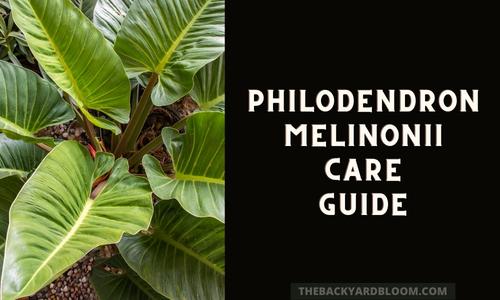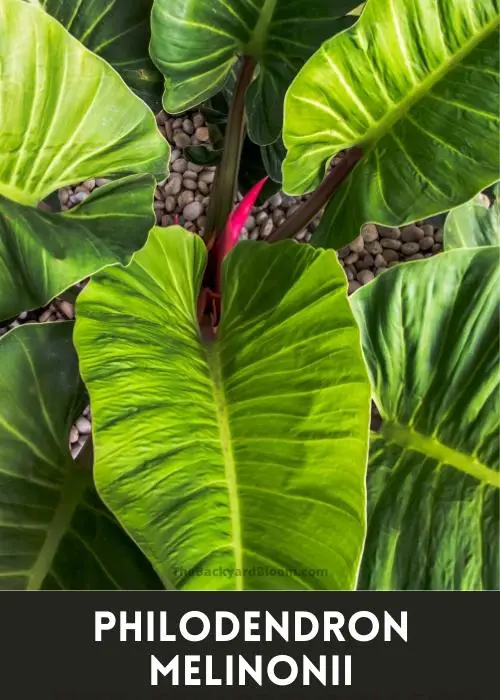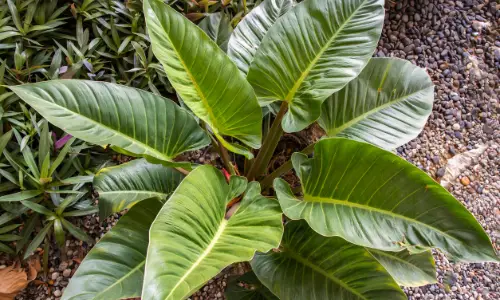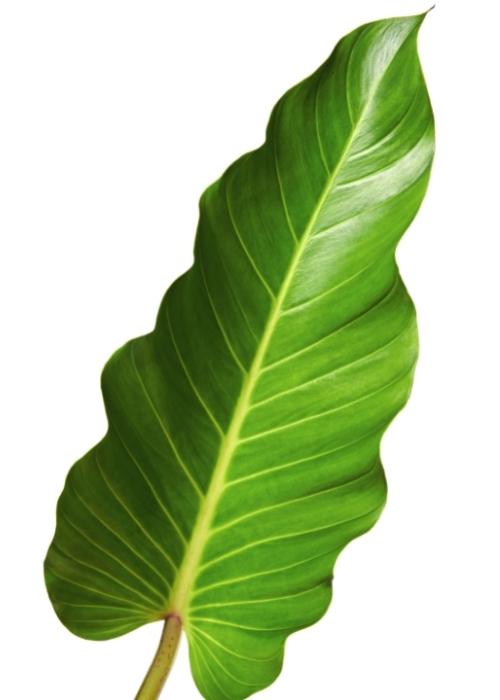Please note that this post may contain affiliate links. You can read my full affiliate disclosure at the bottom of the page.
The Philodendron Melinonii is a surprisingly rare Philodendron plant to find in collections of Philodendron growers. The undersides of young leaves have a red hue that will turn into a green color once it matures and will also take on a heart shape. If you do happen to get your hands on one of these beautiful Philodendrons you might end up wondering how to care for it. In this care guide we go over the care you need to give a Philodendron Melinonii.
Quick Overview Of How to Care For a Philodendron Melinonii
- Bright light, some direct sun is ok.
- Water once the top few inches of soil has become dry.
- Use a well-draining soil mix that has a good amount of bark.
- Temperatures: between 60°F and 85°F
- Humidity above 50%.
- Keep in a pot that has good drainage.
- Fertilize in the spring and summer, once a month.
- Propagation via pups that grow off of the mother plant.
- Toxic to pets.
Origin
The Philodendron Melinonii is native to Northern Brazil, French Guiana, Guyana, Suriname, and Venezuela. It was first identified in 1874. The plant is both epiphytic and terrestrial, meaning that it is found growing on limbs of trees high in the canopy of the rainforest.
Scientific Name: Philodendron melinonii Brongn. ex Regel
Common Name: Philodendron Melinonii
Is the Philodendron Melinonii Rare?
While the Melinonii is common to find in the areas that it is native to, it is a rare Philodendron to find among Philodendron collectors and plant growers.
Other Names
- P. Melinoni
Philodendron Melinonii Varieties
- Philodendron Melinonii Gold (aka Philodendron Golden Melinonii, or Philodendron Melinonii Golden)
The Golden Melinonii leaves are bright yellow-green color instead of the darker green. They look similar to the shades of a Philodendron Moonlight or Lemon Lime.

Watering
Water the plant once the top few inches of soil has dried out. You can test this by using your finger and sticking it down into the soil up to your first or second knuckle.
Do not try to stick to a watering schedule. This can lead to not watering the plant when it needs water, making it easily overwatered or underwater.
Overwatering the plant can lead to root rot. This can be hard to get rid of and to try to save the plant once it sets in.
Light Requirements
Bright indirect light is needed for the Philodendron Melinonii. They can even tolerate direct sun more than other Philodendron cultivars can. The morning sun is the best since it isn’t as harsh as the sun in the later parts of the day. But it can still tolerate an hour of the afternoon sun.
Having periods of sunlight on the Melinonii will help bring out the red colors on the underside of the leaf blades and on the petioles.
Soil
Using a bark-heavy soil mix is best for the Melinonii. Since this is a plant that naturally grows on tree branches, it doesn’t need to have a heavy peat base. You can make your own using the following:
- 20% potting soil
- 10% peat or coco coir
- 40% bark
- 10% perlite
- 10% worm castings
When using coco coir, rinse it out well by flushing it with water before adding it to the mix. Chemical residue can remain on the coir from the production process.
If you can’t make your own mix an orchid soil mixed with some peat and perlite would work too.

Temperature
Ideal temperatures should stay between 60°F and 85°F.
Do not allow the temperature to drop below 55°F. Temperatures lower than 55 can start to have detrimental effects on the plant.
Humidity
As a tropical plant, the Melinonii prefers high humidity. Try to keep humidity above 50%.
You can use a small humidifier near the plant if the humidity keeps dropping too low.
Should You Mist a Philodendron Melinonii?
Misting the plant should be avoided. Often, areas where plants are kept don’t have good airflow, and misting can lead to bacterial leaf spot. If you find that the plant needs more moisture it is best to invest in a humidifier instead.
Fertilizer
Fertilize your plant in the spring and summer months once each month. This is the natural growing season for the plant.
Using an organic liquid fertilizer is best. We recommend Espoma Organic Indoor Plant Food or a Fish Emulsion Fertilizer.

Philodendron Melinonii Size and Growth
The leaves of the Melinonii can grow up to 28 inches long and 20 inches wide. The petioles can reach the same length. The entire plant can get as big as 8 feet across.
The growth rate of the Philodendron Melinonii can be fast, but the rate ultimately depends on the amount of light that the plant is in. The brighter the light, the faster and bigger the plant will grow.
Potting
Pick a pot for your plant that allows for good drainage. No drainage in a pot will lead to soggy soil that causes the plant to sit in stagnant water. Soggy soil is not good for these plants and will cause root rot.

Philodendron Melinonii Propagation
The Melinonii can be propagated via pups that the parent plant produces. You have to dig down into the soil medium and cut away the pups from the parent plant to ensure they have roots to survive once separated.
To get the plant to produce pups it needs a good amount of bright light. Having the plant in an area where it can get morning sun can help even more with getting pups to be produced.
Toxicity
All Philodendron plants are toxic to both cats and dogs. While the ASPCA doesn’t list every cultivar of Philodendron, it is safe to assume that all plants in the family are toxic to pets.
Philodendrons can cause GI upset and swelling in the mouth when ingested. If your pet chews on or eats any part of your plant, contact your vet.
Common Problems and Pests
Spider Mites
Spider mites are usually the most common pests that appear on Philodendron Melinonii plants. Neem oil can be used to get rid of them.
One thing to keep in mind if you keep encountering Spider Mites, they don’t like moisture. So raising the humidity with a humidifier can help deter them from infesting your plant.
Bacterial Leaf Spot
Bacterial leaf spot shows up at first as small dark spots with yellow halos, or small brown spots that become almost transparent. These are very small when they first appear. But will spread if not kept in check.
A copper fungicide on the plant leaves can help with avoiding the spread. Remove any damaged leaves that the spots appeared on. Keep air circulation good around the plant and do not mist the plant. Water droplets left sitting on the leaves can keep this issue coming back again and again.
Where to Find a Philodendron Melinonii For Sale
Since the Melinonii is not a Philodendron that is in many collections they can be harder to find. Especially in plant shops.
Occasionally you might find them on Etsy or in a plant trading group on Facebook. I have seen several varieties come up for sale on Etsy including the Melinonii Gold.
If you do purchase one online be sure to check the ratings and reviews of the sellers. Unfortunately in the online plant area, there are scammers.
Other Care Guides:
- Philodendron Imperial Red
- Philodendron Mamei
- Philodendron Plowmanii
- Philodendron Moonlight
- Heartleaf Philodendron
- Philodendron Dark Lord
- Philodendron Brasil
- Philodendron Burle Marx
- Philodendron Billietiae
- Philodendron Melanochrysum
- Birkin Philodendron
- Silver Sword Philodendron
References:
- Philodendron melinonii Brongn. ex Regel; Tropicos; https://www.tropicos.org/name/2103281
- Philodendron melinonii; Royal Botanic Gardens Kew, Plants of the World Online; https://powo.science.kew.org/taxon/87884-1
- Heartleaf Philodendron | ASPCA; https://www.aspca.org/pet-care/animal-poison-control/toxic-and-non-toxic-plants/heartleaf-philodendron